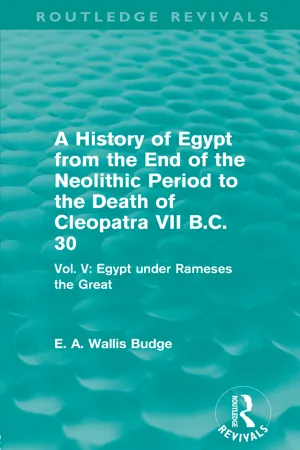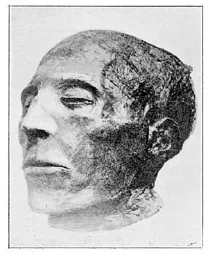![]()
EGYPT
UNDER
RAMESES THE GREAT.
CHAPTER I.
THE NINETEENTH DYNASTY.
1.
RĀ-MEN-
PEḤ-PEḤ, son of the Sun,
RĀ-MESSU [I.].
RĀMESSU I., or
RAMESES I., the first king of the XIXth Dynasty, was apparently related to
Ḥeru-em-
ḥeb, but the degree of relationship cannot at present be defined, and its existence is doubted by some writers. There is certainly no evidence that he was of royal descent, and nothing is known of the circumstances under which he ascended the throne. There are grounds for thinking that he held, like
Ḥeru-em-
ḥeb, high offices under the government for several years before he became king, and that when he succeeded his colleague he was past middle age ; it is more than probable that he exercised in the south of Egypt an authority similar to that which
Ḥeru-em-
ḥeb exercised in the north. Although the name of
Ȧmen does not occur in any of his names or titles he must have been a loyal servant of that god or he would never have been supported by his priests. His reign was very short, certainly less than ten years, and, but for one thing, of which there is no mention in the Egyptian inscriptions of the period, might have been termed uneventful. We have already mentioned the prominent part which the confederation of the Kheta tribes took in the breaking of the power of Egypt in Syria in the reign of
Ȧmen-
ḥetep IV., and since that time Egypt had been able to do nothing to check their advance in Northern Syria. The disruption caused by the heresy of the Disk worshippers prevented the despatch of any army against them during the reigns of the three predecessors of Rameses I., and thus it happened that when this king ascended the throne of Egypt he discovered that he was powerless even to prevent their advance upon territory much nearer to Egypt, still less to regain the old Egyptian possessions near the Euphrates, and he, therefore, made a treaty of peace with Sapalul, the prince of the Kheta tribes. Reference is made to this treaty in the treaty which Sapalul’s descendant made with Rameses II., and it is clear that in the reign of Rameses I. the Kheta were sufficiently powerful to make it worth the while of the Egyptians to be at peace with them. The only military expedition undertaken by Rameses I. was against the Nubians, but whether this took place during the first two years of his reign, when he was sole monarch, or later, when his son Seti I. was co-regent, cannot be said. As a mark of his devotion to
Ȧmen he built the large pylon through which entrance is gained to the great Hypostyle Hall in the temple of the god at Karnak, but of this very little now remains ; on a wall near it he is represented in the act of adoring a number of gods. Rameses I. made a tomb for himself in the Valley of the Tombs of the Kings at Thebes, and was presumably buried in it. It consists of a large hall, with a doorway at each end ; through the further doorway admission is gained to a narrow chamber. The hall is approached by two corridors, which are not ornamented in any way, and the second forms a steep flight of steps which leads directly into the hall or mummy chamber. The walls of the hall are decorated with large figures of the gods Ma
āt, Pta
ḥ, Nefer-Temu, Anubis, Horus, Thoth, Kheper
ȧ, etc., and with inscriptions and scenes from the Book of the Underworld. The sarcophagus is made of red granite and is about five feet high ; it is ornamented with figures of the gods painted in yellow on a red background, and is without a cover. The tomb was very difficult to enter, and its entrance has now been filled up.
1 Among the coffins and mummies from the great D
êr al-Ba
ḥar
î “find” were the fragments of a wooden coffin which had been painted yellow, and a cover which seemed to belong to them. The name of the original owner had been erased and the prenomen of Rameses I. inscribed in its place ; this king
’s prenomen is found on the fragments written both in hieroglyphics and in the hieratic character. On a piece of the coffin are the fragments of an inscription, which by the help of other similar documents has been completed, and from it we learn that on the 13th day of the fourth month of the season Shat of the 16th year of the reign of Sa-
Ȧmen,
, the mummy of Rameses I. was taken from his own tomb into that of queen
Ȧn-
Ḥāpu,
, which was situated near the tomb of
Ȧmen-
ḥetep, in peace. This removal was effected by a priest of
Ȧmen-R
ā called
Ānkh-f-en-
Ȧmen,
, the son of Baki,
, who held several high ecclesiastical offices, and was, apparently, a superintendent of the royal tombs. Near the fragments of the coffin was the unswathed mummy of a man of large and powerful build, with short hair and a black skin ; this mummy is believed by M. Maspero to have been that of Rameses I., and he thinks that its coffin was broken by the various journeys which it had to undergo when the royal mummies were removed to their hiding-place at D
êr al-Ba
ḥar
î, and that the mummy itself was stripped and plundered by the people who were assisting in hiding it from the professional robbers of royal tombs.
1 KA-NEKHT-UATCHSUTENIU, the Horus name of Rameses I.
2.
RĀ-MAĀT- MEN, son of the Sun,
PTAḤ-MERI-EN-SETI.S
ETI I., or “S
ETI-MER-EN-P
TAḤ” I., was the son of Rameses I. ; he married queen Tu
ȧa,
, during the reign of
Ḥeru-em-
ḥeb, and by her became the father of Rameses II. According to Manetho he reigned between fifty and fifty-five years, but there is no monumental evidence in support of this statement. The inscriptions prove that he adopted a large number of Horus names, among which may be mentioned :
— “Mighty Bull, rising in Thebes, vivifying the two lands,” “Mighty Bull, image of Menthu,” “Mighty Bull, son of Temu,” “Bull of R
ā, beloved of Ma
āt,” “Mighty Bull, resting upon Ma
āt,” etc. ; some of his titles were, “He who repeateth [his] births, mighty one of valour, destroyer of the Nine Bows, Mighty one of bows in all lands, subduer of the Menti, stablisher of monuments,” etc.
KA-NEKHT-KHĀ EM-UAST-SEĀNKH- TAUI, the Horus name of Seti I.
As soon as Rameses I. was dead the nomad tribes and peoples who lived in the Eastern Desert and in Palestine revolted, and his son and successor Seti I. found himself obliged to take the field at once against a formidable confederation of hostile hosts. He set out from Egypt against the wretched “Shasu,”
, and marched from the fortress of Tchare,
, to Kan
āna,
, a place which has been thought to be to the south of Hebron ; but Kan
āna refers to the whole country and not to any one portion of it. The Shasu were defeated in the first battle, and large numbers of them were slain. He next attacked the rebels of Khare,
, with the same result, and the king, who is described as the “Sun of Egypt and the moon of all other lands,” swept all before him like the god B
āru,
, wheresoever he went he slew men, and his soldiers following him up carried away much spoil. The chiefs of Rethennu, or Northern Syria, submitted peacefully, and sang praises to the king, and of the presents which they brought to him he made rich gifts to
Ȧmen-R
ā. The city of Kadesh and the fortress of Innu
āamu,
, were also conquered, and the whole country of the Amorites. The tribes of the Kheta, however, refused to follow this example, and therefore Seti I. marched into their country ; he slew their chiefs and passed through their soldiers like a flame of fire, and all that could fled before him.
1 From every part of Syria he obtained either gifts or tribute, and he then retraced his steps to Egypt, leaving the country through which he had passed a place of desolation and misery. Among the spoil brought back was wood for making a boat for the god
Ȧmen-R
ā, and trunks of straight and lofty trees which were to be made into the masts intended to be set up in grooves in front of the main pylons of temples ; the wood and the tree trunks came from the Lebanon mountains, famous then, as later, for their lofty cedars and other trees.
Head of the mummy of Seti I., king of Egypt, B. C. 1370.
When Seti I. arrived at the frontiers of Egypt he was met by the priests and nobles of the country, who received him with shouts of joy, and with all the spoil which he had brought back he set out on the river to make a triumphant progress up the Nile to Thebes. The principal events of the campaign in Palestine and Syria were sculptured on the north and south walls of the great Hypostyle Hall at Karnak, and near each was added a full description in hieroglyphics for every man to see. The king was very proud of his achievements and caused lists of the countries, and cities, and villages which he had conquered to be inscribed upon the buildings and monuments which he set up in Egypt and Nubia. Thus on the north wall of the great hall at Thebes Ȧmen is depicted holding ropes to which are tied by their necks series of representatives of conquered places, each with his name enclosed in a “turreted cartouche” ; the base of a sphinx in the temple of Seti I. at Kûrna also contains a long list of names of conquered places ; and at Redêsîyeh or...

















